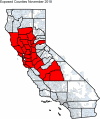Applying a two-stage generalized synthetic control approach to quantify the heterogeneous health effects of extreme weather events: A 2018 large wildfire in California event as a case study
- PMID: 39744585
- PMCID: PMC11692959
- DOI: 10.1097/EE9.0000000000000362
Applying a two-stage generalized synthetic control approach to quantify the heterogeneous health effects of extreme weather events: A 2018 large wildfire in California event as a case study
Abstract
Extreme weather events, including wildfires, are becoming more intense, frequent, and expansive due to climate change, thus increasing negative health outcomes. However, such effects can vary across space, time, and population subgroups, requiring methods that can handle multiple exposed units, account for time-varying confounding, and capture heterogeneous treatment effects. In this article, we proposed an approach based on staggered generalized synthetic control methods to study heterogeneous health effects, using the 2018 California wildfire season as a case study. This study aimed to estimate the effects of the November 2018 California wildfires, one of the state's deadliest and most destructive wildfire seasons, on respiratory and circulatory health, document heterogeneity in health impacts, and investigate drivers of this heterogeneity. We applied a two-stage generalized synthetic control method to compare health outcomes in exposed (from 8 November to 5 December 2018) versus unexposed counties and used random-effects meta-regression to evaluate the effect modification of county-level socioeconomic variables on the observed health effects of the November 2018 wildfires. We observed an increase in respiratory hospitalizations for most exposed counties when compared with unexposed counties, with significant increases in Fresno, San Francisco, San Joaquin, San Mateo, and Santa Clara counties. No effect on circulatory hospitalizations was observed. County-level sociodemographic characteristics seem to not modulate the effects of wildfire smoke on respiratory hospitalizations. This novel two-stage framework can be applied in broader settings to understand spatially and temporally compounded health impacts of climate hazards. We provide codes in R for reproducibility and replication purposes.
Keywords: Air pollution; Climate hazards; Environmental justice; Heterogeneous effect; Quasi-experimental method.
Copyright © 2024 The Authors. Published by Wolters Kluwer Health, Inc. on behalf of The Environmental Epidemiology. All rights reserved.
Conflict of interest statement
The authors declare that they have no conflicts of interest with regard to the content of this report.
Figures





Similar articles
-
Using the Generalized Synthetic Control Method to Estimate the Impact of Extreme Weather Events on Population Health.Epidemiology. 2022 Nov 1;33(6):788-796. doi: 10.1097/EDE.0000000000001539. Epub 2022 Sep 27. Epidemiology. 2022. PMID: 36166207
-
The San Diego 2007 wildfires and Medi-Cal emergency department presentations, inpatient hospitalizations, and outpatient visits: An observational study of smoke exposure periods and a bidirectional case-crossover analysis.PLoS Med. 2018 Jul 10;15(7):e1002601. doi: 10.1371/journal.pmed.1002601. eCollection 2018 Jul. PLoS Med. 2018. PMID: 29990362 Free PMC article.
-
Exploring spatial heterogeneity in synergistic effects of compound climate hazards: Extreme heat and wildfire smoke on cardiorespiratory hospitalizations in California.Sci Adv. 2024 Feb 2;10(5):eadj7264. doi: 10.1126/sciadv.adj7264. Epub 2024 Feb 2. Sci Adv. 2024. PMID: 38306434 Free PMC article.
-
Extreme weather-Wildfires & pregnancy.Semin Perinatol. 2023 Dec;47(8):151839. doi: 10.1016/j.semperi.2023.151839. Epub 2023 Oct 10. Semin Perinatol. 2023. PMID: 37863677 Review.
-
Wildfire smoke exposure under climate change: impact on respiratory health of affected communities.Curr Opin Pulm Med. 2019 Mar;25(2):179-187. doi: 10.1097/MCP.0000000000000552. Curr Opin Pulm Med. 2019. PMID: 30461534 Free PMC article. Review.
References
-
- Dennison PE, Brewer SC, Arnold JD, Moritz MA. Large wildfire trends in the western United States, 1984–2011. Geophys Res Lett. 2014;41:2928–2933.
-
- Parks SA, Abatzoglou JT. Warmer and drier fire seasons contribute to increases in area burned at high severity in western US forests from 1985 to 2017. Geophys Res Lett. 2020;47:e2020GL089858.
-
- Childs ML, Li J, Wen J, et al. . Daily local-level estimates of ambient wildfire smoke PM2.5 for the contiguous US. Environ Sci Technol. 2022;56:13607–13621. - PubMed
